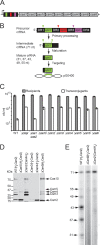Genetic characterization of antiplasmid immunity through a type III-A CRISPR-Cas system
- PMID: 24187086
- PMCID: PMC3911255
- DOI: 10.1128/JB.01130-13
Genetic characterization of antiplasmid immunity through a type III-A CRISPR-Cas system
Abstract
Many prokaryotes possess an adaptive immune system encoded by clustered regularly interspaced short palindromic repeats (CRISPRs). CRISPR loci produce small guide RNAs (crRNAs) that, in conjunction with flanking CRISPR-associated (cas) genes, combat viruses and block plasmid transfer by an antisense targeting mechanism. CRISPR-Cas systems have been classified into three types (I to III) that employ distinct mechanisms of crRNA biogenesis and targeting. The type III-A system in Staphylococcus epidermidis RP62a blocks the transfer of staphylococcal conjugative plasmids and harbors nine cas-csm genes. Previous biochemical analysis indicated that Cas10, Csm2, Csm3, Csm4, and Csm5 form a crRNA-containing ribonucleoprotein complex; however, the roles of these genes toward antiplasmid targeting remain unknown. Here, we determined the cas-csm genes that are required for antiplasmid immunity and used genetic and biochemical analyses to investigate the functions of predicted motifs and domains within these genes. We found that many mutations affected immunity by impacting the formation of the Cas10-Csm complex or crRNA biogenesis. Surprisingly, mutations in the predicted nuclease domains of the members of the Cas10-Csm complex had no detectable effect on antiplasmid immunity or crRNA biogenesis. In contrast, the deletion of csm6 and mutations in the cas10 Palm polymerase domain prevented CRISPR immunity without affecting either complex formation or crRNA production, suggesting their involvement in target destruction. By delineating the genetic requirements of this system, our findings further contribute to the mechanistic understanding of type III CRISPR-Cas systems.
Figures




References
Publication types
MeSH terms
Substances
Grants and funding
LinkOut - more resources
Full Text Sources
Other Literature Sources
Molecular Biology Databases

